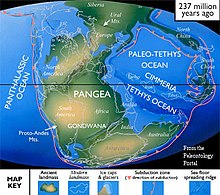
Cimmeria was an ancient continent, or, rather, a string of microcontinents or terranes,[3] that rifted from Gondwana in the Southern Hemisphere and was accreted to Eurasia in the Northern Hemisphere. It consisted of parts of present-day Turkey, Iran, Afghanistan, Pakistan, Tibet, China, Myanmar, Thailand, and Malaysia.[4][5] Cimmeria rifted from the Gondwanan shores of the Paleo-Tethys Ocean during the Early Permian[6] and as the Neo-Tethys Ocean opened behind it, during the Permian, the Paleo-Tethys closed in front of it.[7] Because the different chunks of Cimmeria drifted northward at different rates, a Meso-Tethys Ocean formed between the different fragments during the Cisuralian.[8] Cimmeria rifted off Gondwana from east to west, from Australia to the eastern Mediterranean.[9] It stretched across several latitudes and spanned a wide range of climatic zones.[10]
- ^ a b Reconstruction from Dèzes 1999, p. 16
- ^ Reconstruction from Stampfli & Borel 2002, p. 27
- ^ Cheng, Jian-Bo; Li, Ya-Lin; Li, Shuai; Xiao, Si-Qi; Bi, Wen-Jun; Zou, Yu (December 2022). "Reconstruction of the South Qiangtang–Zhongba–Tethyan Himalaya continental margin system along the northern Indian Plate: Insights from the paleobiogeography of the Zhongba microterrane". Journal of Asian Earth Sciences. 240: 105376. Bibcode:2022JAESc.24005376C. doi:10.1016/j.jseaes.2022.105376. S2CID 252703613. Retrieved 2 April 2023.
- ^ Scotese & McKerrow 1990, pp. 4, 5, 17
- ^ Ruban, Al-Husseini & Iwasaki 2007, pp. 37, 40, 43
- ^ Wang, X.-D; Ueno, K.; Mizuno, Y.; Sugiyama, T. (15 June 2001). "Late Paleozoic faunal, climatic, and geographic changes in the Baoshan block as a Gondwana-derived continental fragment in southwest China". Palaeogeography, Palaeoclimatology, Palaeoecology. 170 (3–4): 197–218. Bibcode:2001PPP...170..197W. doi:10.1016/S0031-0182(01)00228-0. Retrieved 17 October 2022.
- ^ Golonka 2007, p. 182
- ^ Xu, Hai Peng; Zhang, Yi-chun; Yuan, Dong-xun; Shen, Shu Zhong (1 September 2022). "Quantitative palaeobiogeography of the Kungurian–Roadian brachiopod faunas in the Tethys: Implications of allometric drifting of Cimmerian blocks and opening of the Meso-Tethys Ocean". Palaeogeography, Palaeoclimatology, Palaeoecology. 601: 111078. Bibcode:2022PPP...60111078X. doi:10.1016/j.palaeo.2022.111078.
- ^ Stampfli & Borel 2002, pp. 24, 28
- ^ Metcalfe 2002, p. 556


